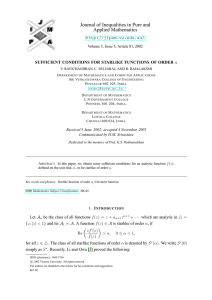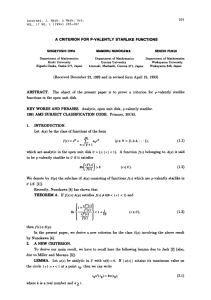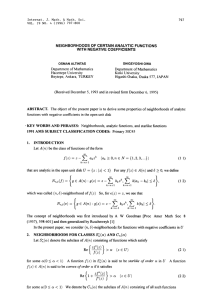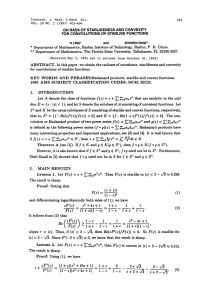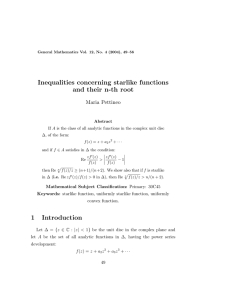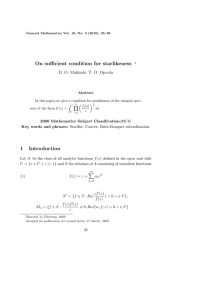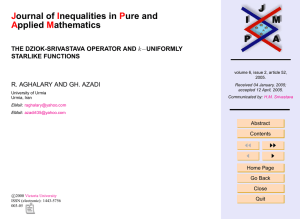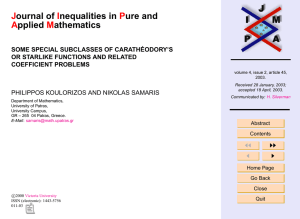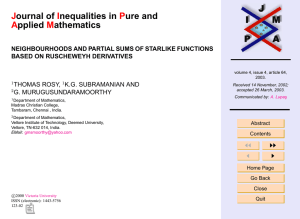J I P A
advertisement
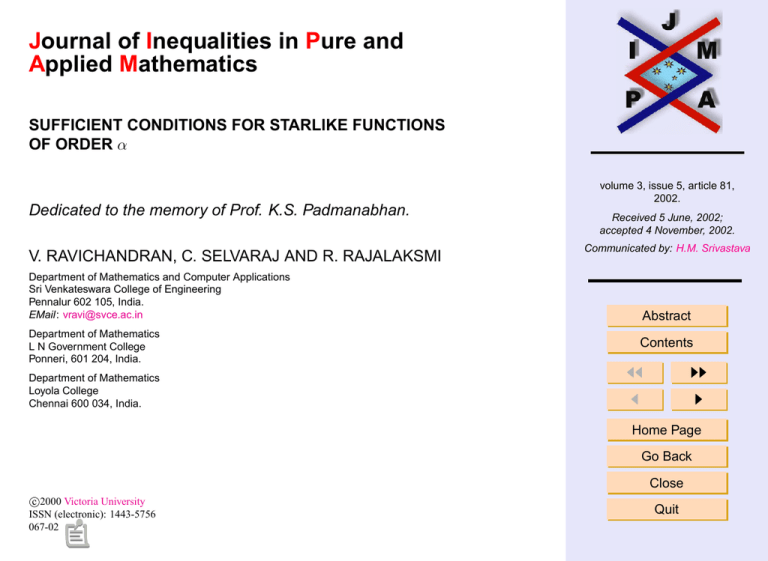
Journal of Inequalities in Pure and
Applied Mathematics
SUFFICIENT CONDITIONS FOR STARLIKE FUNCTIONS
OF ORDER α
Dedicated to the memory of Prof. K.S. Padmanabhan.
V. RAVICHANDRAN, C. SELVARAJ AND R. RAJALAKSMI
Department of Mathematics and Computer Applications
Sri Venkateswara College of Engineering
Pennalur 602 105, India.
EMail: vravi@svce.ac.in
Department of Mathematics
L N Government College
Ponneri, 601 204, India.
Department of Mathematics
Loyola College
Chennai 600 034, India.
volume 3, issue 5, article 81,
2002.
Received 5 June, 2002;
accepted 4 November, 2002.
Communicated by: H.M. Srivastava
Abstract
Contents
JJ
J
II
I
Home Page
Go Back
Close
c
2000
Victoria University
ISSN (electronic): 1443-5756
067-02
Quit
Abstract
In this paper, we obtain some sufficient conditions for an analytic function f(z),
defined on the unit disk 4, to be starlike of order α.
2000 Mathematics Subject Classification: 30C45.
Key words: Starlike function of order α, Univalent function.
Sufficient Conditions for
Starlike Functions of Order α
The authors are thankful to the referee for his comments and suggestions.
V. Ravichandran, C. Selvaraj and
R. Rajalaksmi
Contents
1
Introduction . . . . . . . . . . . . . . . . . . . . . . . . . . . . . . . . . . . . . . . . .
2
Sufficient Conditions for Starlikeness . . . . . . . . . . . . . . . . . . . .
References
3
5
Title Page
Contents
JJ
J
II
I
Go Back
Close
Quit
Page 2 of 11
J. Ineq. Pure and Appl. Math. 3(5) Art. 81, 2002
http://jipam.vu.edu.au
1.
Introduction
Let An be the class of all functions f (z) = z + an+1 z n+1 + · · · which are
analytic in 4 = {z; |z| < 1} and let A1 = A. A function f (z) ∈ A is starlike
of order α, if
0 zf (z)
Re
> α, 0 ≤ α < 1,
f (z)
for all z ∈ 4. The class of all starlike functions of order α is denoted by S ∗ (α).
We write S ∗ (0) simply as S ∗ . Recently, Li and Owa [3] proved the following:
Theorem 1.1. If f (z) ∈ A satisfies
0
zf (z)
zf 00 (z)
α
Re
α 0
+1
>− ,
f (z)
f (z)
2
Sufficient Conditions for
Starlike Functions of Order α
V. Ravichandran, C. Selvaraj and
R. Rajalaksmi
z ∈ 4,
Title Page
for some α (α ≥ 0), then f (z) ∈ S ∗ .
Contents
In fact, Lewandowski, Miller and Zlotkiewicz [1] and Ramesha, Kumar, and
Padmanabhan [7] have proved a weaker form of the above theorem. If the
number −α/2 is replaced by −α2 (1−α)/4, (0 ≤ α < 2) in the above condition,
Li and Owa [3] have proved that f (z) is in S ∗ (α/2).
Li and Owa [3] have also proved the following:
Theorem 1.2. If f (z) ∈ A satisfies
00
zf (z) zf 0 (z)
− 1 < ρ,
f 0 (z)
f (z)
where ρ = 2.2443697, then f (z) ∈ S ∗ .
JJ
J
II
I
Go Back
Close
Quit
z ∈ 4,
Page 3 of 11
J. Ineq. Pure and Appl. Math. 3(5) Art. 81, 2002
http://jipam.vu.edu.au
The above theorem with ρ = 3/2 and ρ = 1/6 were earlier proved by Li and
Owa [2] and Obradovic [6] respectively.
In this paper, we obtain some sufficient conditions for functions to be starlike
of order β. To prove our result, we need the following:
Lemma 1.3. [4] Let Ω be a set in the complex plane C and suppose that Φ is a
mapping from C 2 × 4 to C which satisfies Φ(ix, y; z) 6∈ Ω for z ∈ 4, and for
all real x, y such that y ≤ −n(1 + x2 )/2. If the function p(z) = 1 + cn z n + · · ·
is analytic in 4 and Φ(p(z), zp0 (z); z) ∈ Ω for all z ∈ 4, then Re p(z) > 0.
Sufficient Conditions for
Starlike Functions of Order α
V. Ravichandran, C. Selvaraj and
R. Rajalaksmi
Title Page
Contents
JJ
J
II
I
Go Back
Close
Quit
Page 4 of 11
J. Ineq. Pure and Appl. Math. 3(5) Art. 81, 2002
http://jipam.vu.edu.au
2.
Sufficient Conditions for Starlikeness
In this section, we prove some sufficient conditions for function to be starlike
of order β.
Theorem 2.1. If f (z) ∈ An satisfies
0
zf 00 (z)
zf (z)
α 0
+1
Re
f (z)
f (z)
i h
h
n
αn i
> αβ β + − 1 + β −
, z ∈ 4, 0 ≤ α, β ≤ 1,
2
2
then f (z) ∈ S ∗ (β).
Sufficient Conditions for
Starlike Functions of Order α
V. Ravichandran, C. Selvaraj and
R. Rajalaksmi
Proof. Define p(z) by
(1 − β)p(z) + β =
zf 0 (z)
.
f (z)
Then p(z) = 1 + cn z n + · · · and is analytic in 4. A computation shows that
(1 − β)zp0 (z) + [(1 − β)p(z) + β]2 − [(1 − β)p(z) + β]
zf 00 (z)
=
f 0 (z)
(1 − β)p(z) + β
and hence
zf 0 (z)
zf 00 (z)
α 0
+ 1 = α(1 − β)zp0 (z) + α(1 − β)2 p2 (z)
f (z)
f (z)
+ (1 − β)(1 + 2αβ − α)p(z) + β[αβ + 1 − α]
= Φ(p(z), zp0 (z); z),
Title Page
Contents
JJ
J
II
I
Go Back
Close
Quit
Page 5 of 11
J. Ineq. Pure and Appl. Math. 3(5) Art. 81, 2002
http://jipam.vu.edu.au
where
Φ(r, s; t) = α(1 − β)s + α(1 − β)2 r2 + (1 − β)(1 + 2αβ − α)r + β[αβ + 1 − α].
For all real x and y satisfying y ≤ −n(1 + x2 )/2, we have
Re Φ(ix, y; z) = α(1 − β)y − α(1 − β)2 x2 + β[αβ + 1 − α]
h nα
i
α
≤ − (1 − β)n −
(1 − β) + α(1 − β)2 x2 + β[αβ + 1 − α]
2
2
α
α(1 − β)
= − (1 − β)n −
(n + 2 − 2β)x2 + β(αβ + 1 − α)
2
2
α
≤ β(αβ + 1 − α) − (1 − β)n
2
n
nα = αβ β + − 1 + β −
.
2
2
. Then Φ(p(z), zp0 (z); z)
Let Ω = w; Re w > αβ β + n2 − 1 + β − nα
2
∈ Ω and Φ(ix, y; z) 6∈ Ω for all real x and y ≤ −n(1 + x2 )/2, z ∈ 4. By an
application of Lemma 1.3, the result follows.
By taking β = 0 and n = 1 in the above theorem, we have the following:
Corollary 2.2. [3] If f (z) ∈ A satisfies
0
zf (z)
zf 00 (z)
α
Re
α 0
+1
>− ,
f (z)
f (z)
2
for some α (α ≥ 0), then f (z) ∈ S ∗ .
If we take β = α/2 and n = 1, we get the following:
Sufficient Conditions for
Starlike Functions of Order α
V. Ravichandran, C. Selvaraj and
R. Rajalaksmi
Title Page
Contents
JJ
J
II
I
Go Back
Close
z ∈ 4,
Quit
Page 6 of 11
J. Ineq. Pure and Appl. Math. 3(5) Art. 81, 2002
http://jipam.vu.edu.au
Corollary 2.3. [3] If f (z) ∈ A satisfies
0
zf (z)
zf 00 (z)
α2
Re
α 0
+1
> − (1 − α),
f (z)
f (z)
4
z ∈ 4,
for some α (0 < α ≤ 2), then f (z) ∈ S ∗ (α/2).
In fact, in the proof of the above theorem, we have proved the following: If
p(z) = 1 + cn z n + · · · is analytic in 4 and satisfies
Re(α(1 − β)zp0 (z) + α(1 − β)2 p2 (z)
+ (1 − β)(1 + 2αβ − α)p(z) + β[αβ + 1 − α])
h
i n
αn > αβ β + − 1 + β −
,
2
2
then Re p(z) > 0. Using a method similar to the one used in the above theorem,
we have the following:
Theorem 2.4. Let α ≥ 0, 0 ≤ β < 1. If f (z) ∈ An satisfies
f (z)
zf 0 (z)
n
Re
α
+1−α
> − α(1 − β) + β,
z
f (z)
2
then
f (z)
> β.
z
As a special case, we get the following: If f (z) ∈ A satisfies
Re
α
Re {f 0 (z) + αzf 00 (z)} > − ,
2
z ∈ 4,
z ∈ 4,
Sufficient Conditions for
Starlike Functions of Order α
V. Ravichandran, C. Selvaraj and
R. Rajalaksmi
Title Page
Contents
JJ
J
II
I
Go Back
Close
Quit
Page 7 of 11
J. Ineq. Pure and Appl. Math. 3(5) Art. 81, 2002
http://jipam.vu.edu.au
α ≥ 0, then
Re f 0 (z) > 0.
However, a sharp form of this result was proved by Nunokawa and Hoshino [5].
Theorem 2.5. Let 0 ≤ β < 1, a = (n/2 + 1 − β)2 and b = (n/2 + β)2 satisfy
(a + b)β 2 < b(1 − 2β). Let t0 be the positive real root of the equation
2a(1 − β)2 t2 + [3aβ 2 + b(1 − β)2 ]t + [(a + 2b)β 2 − (1 − β)2 b] = 0
and
ρ2 =
(1 − β)3 (1 + t0 )2 (at0 + b)
.
β 2 + (1 − β)2 t0
If f (z) ∈ An satisfies
00
zf (z) zf 0 (z)
≤ ρ,
−
1
f 0 (z)
f (z)
Sufficient Conditions for
Starlike Functions of Order α
V. Ravichandran, C. Selvaraj and
R. Rajalaksmi
Title Page
z ∈ 4,
Contents
JJ
J
then f (z) ∈ S ∗ (β).
Proof. Define p(z) by
zf 0 (z)
(1 − β)p(z) + β =
.
f (z)
Then p(z) = 1 + cn z n + · · · and is analytic in 4. A computation shows that
zf 00 (z)
(1 − β)zp0 (z) + [(1 − β)p(z) + β]2 − [(1 − β)p(z) + β]
=
f 0 (z)
(1 − β)p(z) + β
II
I
Go Back
Close
Quit
Page 8 of 11
J. Ineq. Pure and Appl. Math. 3(5) Art. 81, 2002
http://jipam.vu.edu.au
and hence
zf 00 (z) zf 0 (z)
(1 − β)(p(z) − 1)
−1 =
[(1 − β)zp0 (z)
0
f (z)
f (z)
(1 − β)p(z) + β
+ [(1 − β)p(z) + β]2 − [(1 − β)p(z) + β)]]
≡ Φ(p(z), zp0 (z); z).
Then, for all real x and y satisfying y ≤ −n(1 + x2 )/2, we have
|Φ(ix, y; z)|2
(1 − β)2 (1 + x2 ) = 2
[(1 − β)y − β + β 2 − (1 − β)2 x2 ]2
β + (1 − β)2 x2
+[2β(1 − β) − (1 − β)]2 x2
(1 − β)2 (1 + t)
= 2
{[(1 − β)y − β + β 2 − (1 − β)2 t]2
β + (1 − β)2 t
+ [2β(1 − β) − (1 − β)]2 t}
≡ g(t, y),
where t = x2 > 0 and y ≤ −n(1 + t)/2. Since
∂g
(1 − β)3 (1 + t)
= 2
[(1 − β)y − β + β 2 − (1 − β)2 t]2 < 0,
2
∂y
β + (1 − β) t
we have
Sufficient Conditions for
Starlike Functions of Order α
V. Ravichandran, C. Selvaraj and
R. Rajalaksmi
Title Page
Contents
JJ
J
II
I
Go Back
Close
Quit
Page 9 of 11
n
g(t, y) ≥ g t, − (1 + t) ≡ h(t).
2
J. Ineq. Pure and Appl. Math. 3(5) Art. 81, 2002
http://jipam.vu.edu.au
Note that
2 n
2 (1 − β)3 (1 + t)2 n
h(t) = 2
t
+1−β +
+β
.
β + (1 − β)2 t
2
2
Also it is clear that h0 (−1) = 0 and the other two roots of h0 (t) = 0 are given
by
2a(1 − β)2 t2 + [3aβ 2 + b(1 − β)2 ]t + [(a + 2b)β 2 − (1 − β)2 b] = 0,
where a = (n/2 + 1 − β)2 and b = (n/2 + β)2 . Since t0 is the positive root of
this equation we have h(t) ≥ h(t0 ) and hence
Sufficient Conditions for
Starlike Functions of Order α
V. Ravichandran, C. Selvaraj and
R. Rajalaksmi
|Φ(ix, y; z)|2 ≥ h(t0 ).
Define Ω = {w; |w| < ρ}. Then Φ(p(z), zp0 (z); z) ∈ Ω and Φ(ix, y; z) 6∈ Ω
for all real x and y ≤ −n(1 + x2 )/2, z ∈ 4. Therefore by an application of
Lemma 1.3, the result follows.
√
If we take n = 1, β = 0, we have t0 =
following:
73−1
36
Corollary 2.6. [3] If f (z) ∈ A satisfies
00
zf (z) zf 0 (z)
− 1 < ρ,
f 0 (z)
f (z)
where ρ2 =
√
827+73 73
,
288
and therefore we have the
Title Page
Contents
JJ
J
II
I
Go Back
Close
z ∈ 4,
Quit
Page 10 of 11
then f (z) ∈ S ∗ .
J. Ineq. Pure and Appl. Math. 3(5) Art. 81, 2002
http://jipam.vu.edu.au
References
[1] Z. LEWANDOWSKI, S.S. MILLER AND E. ZŁOTKIEWICZ, Generating
functions for some classes of univalent functions, Proc. Amer. Math. Soc.,
56 (1976), 111–117.
[2] J.-L. LI AND S. OWA, Properties of the Salagean operator, Georgian Math.
J., 5(4) (1998), 361–366.
[3] J.-L. LI AND S. OWA, Sufficient conditions for starlikeness, Indian J. Pure
Appl. Math., 33 (2002), 313–318.
[4] S.S. MILLER AND P.T. MOCANU, Differential subordinations and inequalities in the complex plane, J. Differ. Equations, 67 (1987), 199–211.
[5] M. NUNOKAWA AND S. HOSHINO, One criterion for multivalent functions, Proc. Japan Acad., Ser. A, 67 (1991), 35–37.
Sufficient Conditions for
Starlike Functions of Order α
V. Ravichandran, C. Selvaraj and
R. Rajalaksmi
Title Page
Contents
[6] M. OBRADOVIĆ, Ruscheweyh derivatives and some classes of univalent
functions, in: Current Topics in Analytic Function Theory, (H.M. Srivastava
and S. Owa, Editors), World Sci. Publishing, River Edge, NJ, 1992, pp.
220–233.
[7] C. RAMESHA, S. KUMAR AND K.S. PADMANABHAN, A sufficient
condition for starlikeness, Chinese J. Math., 23 (1995), 167–171.
JJ
J
II
I
Go Back
Close
Quit
Page 11 of 11
J. Ineq. Pure and Appl. Math. 3(5) Art. 81, 2002
http://jipam.vu.edu.au
